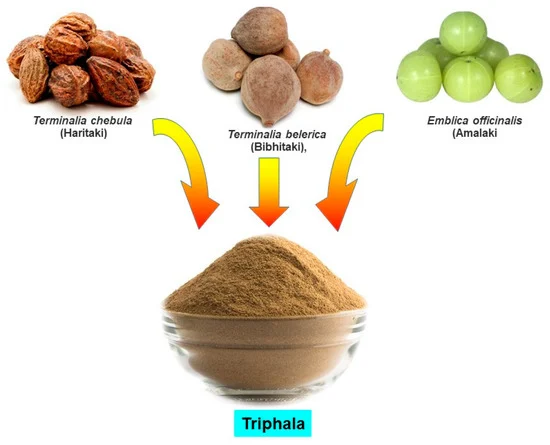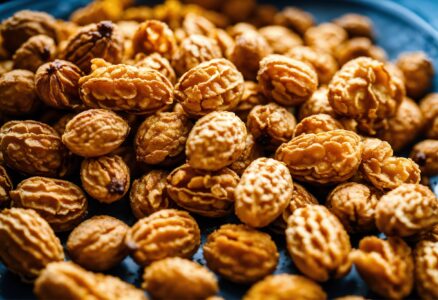Indians are no strangers to Triphala. It is an ancient herbal concoction that derives its potency from a blend of three dried fruits: Terminalia chebula (black myrobalan), Terminalia bellerica (bastard myrobalan), and Phyllantus emblica (emblic myrobalan or Indian gooseberry). Each of these fruits has unique therapeutic properties to the formulation, making Triphala a revered staple in Ayurvedic medicine. Here are some benefits of ingesting this ‘bitter drink’ for a sweet life.
Digestive Panacea
Triphala has earned its stripes as a digestive tonic par excellence. Its unique blend of herbs stimulates digestive juices, enhances liver function, and promotes regular bowel movements. The synergy of amla, haritaki, and bibhitaki in Triphala helps to maintain gastrointestinal health by regulating bowel movements, alleviating constipation, and soothing digestive discomfort. Its gentle yet effective action makes it suitable for regular consumption to maintain digestive harmony.

Img Src:-www.mdpi.com
Triphala Antioxidant Properties
In an era where oxidative stress wreaks havoc on cellular health, Triphala is a formidable ally. Rich in polyphenols, flavonoids, and vitamin C, this herbal formulation exerts potent antioxidant effects, scavenging free radicals and shielding cells from damage. Regular consumption of Triphala helps to fortify the body’s natural defence mechanisms, thwarting the onslaught of oxidative stress and bolstering overall well-being.
Immune System Booster
Its immune-boosting prowess has a holistic healing potential. Amla, the cornerstone of Triphala, is renowned for its immune-enhancing properties, while haritaki and bibhitaki complement their action with their rejuvenating and detoxifying effects. Triphala empowers the body to fend off infections, combat inflammation, and maintain vitality, thus serving as a cornerstone of preventive healthcare.

Regulates Blood Sugar Levels
Triphala’s ability to regulate blood sugar levels makes it a valuable adjunct in managing diabetes and metabolic disorders. Studies showcase that Triphala helps to modulate glucose metabolism, enhance insulin sensitivity, and mitigate the complications associated with diabetes. Its multifaceted approach addresses the underlying factors contributing to dysglycemia, offering a natural and holistic solution for blood sugar management.
Enhances Detoxification and Cleansing
Those in the pursuit of optimal health will find how its detoxification assumes paramount importance. Triphala is a quintessential detoxifier, facilitating the elimination of toxins, metabolic wastes, and impurities from the body. Its gentle yet thorough cleansing action purges the system of accumulated debris, rejuvenating the organs, and restoring balance. By supporting detoxification pathways, Triphala promotes radiant skin, vibrant energy, and inner vitality.
When to Consume: Before and After Meals
For optimal efficacy, Triphala is typically consumed on an empty stomach, either in the morning or before bedtime. The recommended dosage varies depending on individual constitution and health goals, ranging from 500 mg to 2 grams per day. Triphala can be consumed in powder form, capsules, or decoction, custom-made to personal preferences and convenience.
- Before Meals: Consuming Triphala before meals primes the digestive system, stimulating gastric secretions, and enhancing nutrient absorption. It prepares the gastrointestinal tract for the forthcoming meal, optimizing digestion, and assimilation.
- After Meals: Triphala taken after meals aids in postprandial digestion, alleviating bloating, gas, and indigestion. Its gentle laxative action facilitates the timely elimination of food residues, preventing stagnation and promoting gastrointestinal comfort.
While Triphala’s roots lie deep in the annals of Ayurveda, its acclaim has exceeded geographical boundaries, garnering attention, and admiration worldwide. From India to the farthest reaches of the globe, Triphala has found resonance among health enthusiasts, holistic practitioners, and wellness seekers alike. Its natural, time-tested efficacy resonates with individuals seeking sustainable solutions for health optimization and disease prevention.
Click Here For More Health Related Information
Conclusion
Triphala stands as a testament to the profound wisdom of ancient Indian medicine. Its blend of three powerful fruits offers a holistic approach to health, addressing digestion, immunity, blood sugar regulation, detoxification, and cleansing. Whether as a daily supplement or a targeted remedy, Triphala continues to prove its worth in modern times, bridging the gap between tradition and contemporary wellness practices.
FAQs
Q: What is Triphala? A: Triphala is an ancient herbal formulation made from three dried fruits: Terminalia chebula, Terminalia bellerica, and Phyllantus emblica. It is renowned for its digestive, antioxidant, and immune-boosting properties.
Q: How does Triphala help in digestion? A: Triphala stimulates digestive juices, enhances liver function, and promotes regular bowel movements. It regulates bowel movements, alleviates constipation, and soothes digestive discomfort.
Q: Can Triphala be consumed daily? A: Yes, Triphala is safe for regular consumption. It can be taken daily to maintain digestive harmony and overall well-being.
Q: Are there any side effects of Triphala? A: While Triphala is generally safe, some individuals may experience mild side effects such as gastrointestinal discomfort or diarrhea. It is advisable to consult a healthcare professional before starting any new supplement regimen.
Q: Is Triphala suitable for children? A: Triphala is generally safe for children, but it is recommended to consult a healthcare professional before giving it to children, especially in specific dosages.










